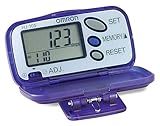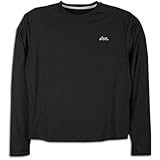 In a collaborative effort with Scott over at Straight to the Bar, we will be writing about exercise equipment throughout the month of January.
In a collaborative effort with Scott over at Straight to the Bar, we will be writing about exercise equipment throughout the month of January.
This week I would like to talk about common toys that runners get. To be a runner you really do not need much; some shorts and a pair of shoes will get most people going, and the shoes are optional. Once you have been running for a while, though, you might want to start playing with some of the toys that can make running more interesting, more fun, or at least more measured. Here are some of the common ones.
Watches
 The first accessory that most runners add is a watch. Sports watches will usually have at least a timer; you hit start when you begin and stop when you get where you are going. You can also get watches with lap memory and count down timers. Some watches will allow you to program a workout ahead of time and will let you know when it is time to start the next leg of your workout. If you time your run over a measured distance, you can determine how fast you are going. While a watch is not necessary, it can let you know how you are improving as you do similar workouts in your training.
The first accessory that most runners add is a watch. Sports watches will usually have at least a timer; you hit start when you begin and stop when you get where you are going. You can also get watches with lap memory and count down timers. Some watches will allow you to program a workout ahead of time and will let you know when it is time to start the next leg of your workout. If you time your run over a measured distance, you can determine how fast you are going. While a watch is not necessary, it can let you know how you are improving as you do similar workouts in your training.
Heart Rate Monitors
 Heart rate monitors usually involve wearing a strap around your chest and a special watch that can display measurements that are sent wirelessly from the strap. By training with a heart rate monitor, you can determine exactly how hard you are working rather than relying upon a rough estimate.
Heart rate monitors usually involve wearing a strap around your chest and a special watch that can display measurements that are sent wirelessly from the strap. By training with a heart rate monitor, you can determine exactly how hard you are working rather than relying upon a rough estimate.
Pedometers
 Pedometers cover a wide range of devices from simple ones that tell you how many steps that you have taken to complex ones that tell you exactly how far you ran and track your pace over time. They may attach to your belt or shoe, or they might include a watch that will display the results of what it is tracking. They may even talk to you through your mp3 player. Pedometers will not always be completely accurate, but the better ones can be calibrated to near 95% accuracy.
Pedometers cover a wide range of devices from simple ones that tell you how many steps that you have taken to complex ones that tell you exactly how far you ran and track your pace over time. They may attach to your belt or shoe, or they might include a watch that will display the results of what it is tracking. They may even talk to you through your mp3 player. Pedometers will not always be completely accurate, but the better ones can be calibrated to near 95% accuracy.
GPS Receivers
 GPS Receivers are like pedometers, except that rather than tracking how many steps you take they track how far you have travelled in relation to a satelite that is orbiting the earth. As long as you have an unobstructed view of the sky, these can be very accurate. Most models will allow you to track your runs and download them to your computer so that you can see your pace over time and elevation. Some combine all of the features that you would find in a wrist watch and a heart rate monitor in one package.
GPS Receivers are like pedometers, except that rather than tracking how many steps you take they track how far you have travelled in relation to a satelite that is orbiting the earth. As long as you have an unobstructed view of the sky, these can be very accurate. Most models will allow you to track your runs and download them to your computer so that you can see your pace over time and elevation. Some combine all of the features that you would find in a wrist watch and a heart rate monitor in one package.
Audio Devices
 MP3 players, cd players, cassette walkmen and other similar devices are very popular. I do not personally support using them when running near other people or traffic, but they are still a popular toy that many people like to wear when they are hitting the streets. You can multitask on your run by carrying music or an audio book along with you.
MP3 players, cd players, cassette walkmen and other similar devices are very popular. I do not personally support using them when running near other people or traffic, but they are still a popular toy that many people like to wear when they are hitting the streets. You can multitask on your run by carrying music or an audio book along with you.
Technical Fabrics
 A little bit less techy but much more easily embraced by all and sundry, technical fabrics have done their best to keep us from getting chafed or over heated or frost bitten. Whether you got the shirt from a race or spent as much on one pair of socks as a package costs of your normal ones, technical products such as cool-max wick moisture away from your skin and are much less abrasive than cotton. You will not want to wear cotten any more once you begin getting technical t-shirts, clothes, and running pants. You may also finding a good, breathable wind breaker will do well as a top level shell to wear over those technical shirts when you are running out in the cold.
A little bit less techy but much more easily embraced by all and sundry, technical fabrics have done their best to keep us from getting chafed or over heated or frost bitten. Whether you got the shirt from a race or spent as much on one pair of socks as a package costs of your normal ones, technical products such as cool-max wick moisture away from your skin and are much less abrasive than cotton. You will not want to wear cotten any more once you begin getting technical t-shirts, clothes, and running pants. You may also finding a good, breathable wind breaker will do well as a top level shell to wear over those technical shirts when you are running out in the cold.
Headlamps, reflective materials and blinkers
 Headlamps, reflective materials, and blinking lights have made it much safer to go outside and run when it is dark out. Being seen is important to keep from getting run over, and being able to see makes it much less likely you will step in a pot hole or trip on a curb. In my case, it has not done much to keep from running headfirst into random branches that hang over the road.
Headlamps, reflective materials, and blinking lights have made it much safer to go outside and run when it is dark out. Being seen is important to keep from getting run over, and being able to see makes it much less likely you will step in a pot hole or trip on a curb. In my case, it has not done much to keep from running headfirst into random branches that hang over the road.
Water bottles
 Water bottles can be something as simple as a gallon jug left in the back of a pickup truck, a water bottle with a squeeze handle, or a fuelt belt that allows you to carry smaller water bottles around your waist. Keeping hydrated is important, and runners have come up with multiple ways of keeping their water with them on the run. The most common ones that you will see are fanny packs that carry a normal bicycle water bottle, and fuel belts that have palm sized water bottle contoured slightly to fit behind you. I am a bigger fan of leaving water out somewhere; if you bury it then it will stay cold and will usually be undisturbed.
Water bottles can be something as simple as a gallon jug left in the back of a pickup truck, a water bottle with a squeeze handle, or a fuelt belt that allows you to carry smaller water bottles around your waist. Keeping hydrated is important, and runners have come up with multiple ways of keeping their water with them on the run. The most common ones that you will see are fanny packs that carry a normal bicycle water bottle, and fuel belts that have palm sized water bottle contoured slightly to fit behind you. I am a bigger fan of leaving water out somewhere; if you bury it then it will stay cold and will usually be undisturbed.
These are a few of the toys that runners eventually consider purchasing. They may not buy all of them, but at one point or another they will seriously try to decide whether something on there is worth picking up or not. After getting the stop watch, though, the most important thing to purchase to become a serious runner is a pencil and a piece of paper in order to keep a training log. What you do not measure, you can not improve.
Recent Comments: